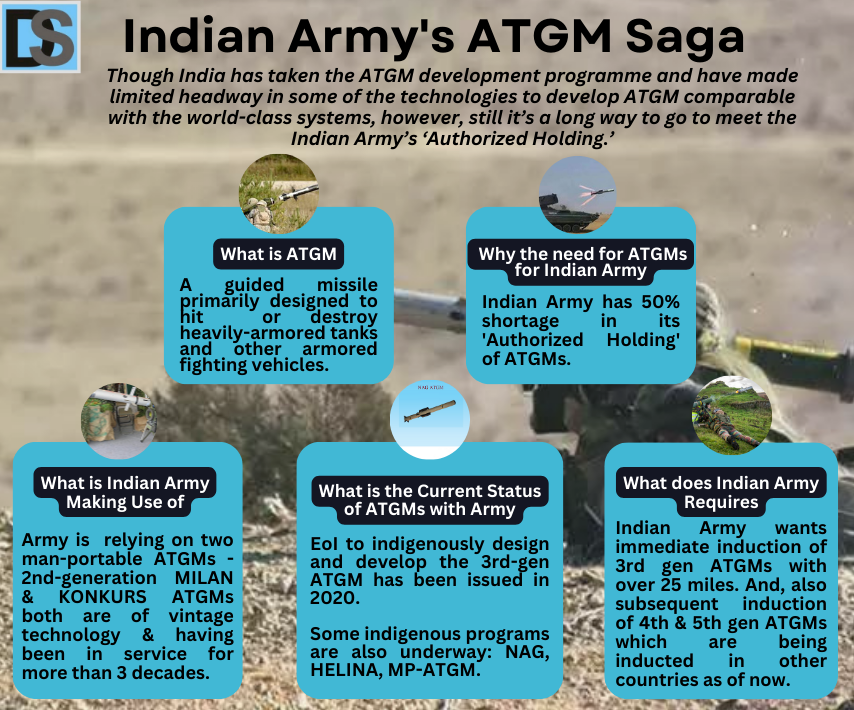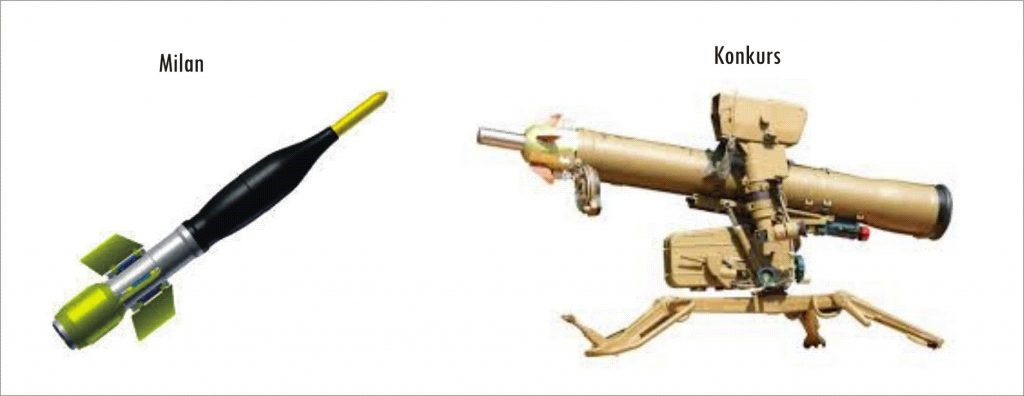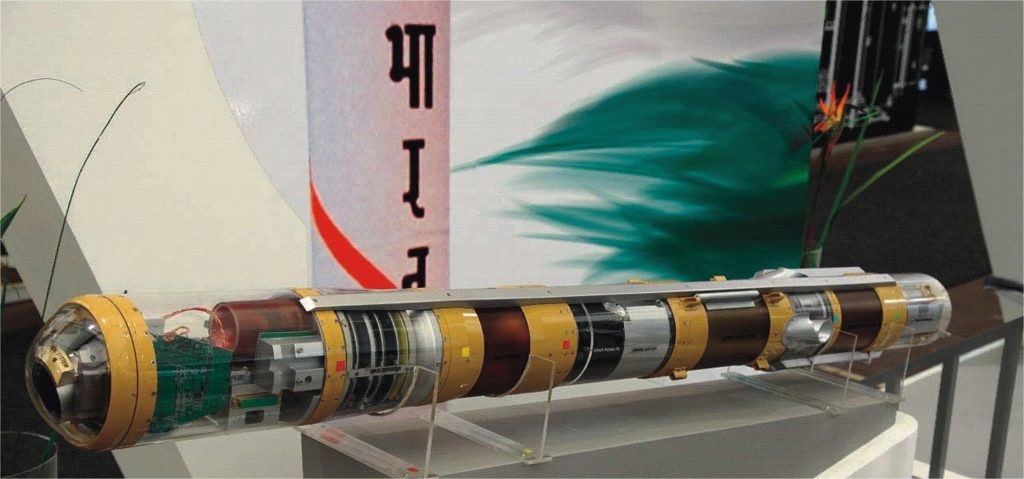Article by Kavita Nagpal & Ritika Behal
Though India has taken the ATGM development programme and have made limited headway in some of the technologies to develop ATGM comparable with the world-class systems, however, still it’s a long way to go to meet the ‘Authorized Holding’ of Indian Army.
Introduction
An Anti-Tank Guided Missile (ATGM) or Anti-Tank Guided Weapon (ATGW) is a guided missile primarily designed to hit and destroy heavily-armored tanks and other armored fighting vehicles.
These range in size from shoulder-launched weapons which can be transported by a single soldier, to larger tripod-mounted weapons which require a squad or team to transport and fire, to vehicle and aircraft mounted missile systems.
At present, ATGMs are being used over by more than 130 countries and many non-state actors around the world. Some of the modern and popular ATGMs world over is AGM-114R, Spike, Javelin, and Red Arrow 12, Milan and Konkur.
Current Inventory of ATGMs with Indian Army
In the Indian context, the Indian Army has a long overdue requirement of around 70,000 Anti-Tank Guided Missiles of various types and over 850 launchers to equip 382 infantry battalions and 44 mechanized infantry.
However, it does not have even half of that number in the inventory, i.e. a shortage of over 40000 missiles of its requirement, which comes to roughly around 50%.
The Army units deployed in the plains are supposed to be armed with four medium-range and long-range ATGM launchers (each with six missiles), while, the units in Mountains Division are required to be equipped with one Launcher of each type along with six missiles.

Currently, infantry units of the Indian Army are relying on two man-portable ATGMs – the second-generation Milan and Konkurs ATGMs – of different variants produced by DPSU Bharat Dynamics Limited (BDL) under license from French and Russian companies.
Notably, while the second-generation French Milan, made by MBDA has a range of just more than 1 mile; the Russian Konkurs ATGM, designed and made by Tula Machinery Design Bureau, has a range of around 2.5 miles.
Understandably, both the current systems are deficient in advanced technologies, primarily the guidance parameters (guided by wire), short range and do not have night-fighting capabilities that mark the third and higher generation versions.
Also, to be noted, that these are based on vintage technology and most of them having been in service for more than three decades and requires a skilled and well-trained operator.
Hence, it is imperative that the Infantry is equipped with an advanced high technology based ATGM system with better accuracy, day and night capabilities and increased survivability which also lends itself to higher mobility due to its weight configuration to meet the enhanced threat.
The Army’s requirement envisages the upgradation from the current wire-guided ATGMs in the inventory to 3rd and gradually 4th generation ones that are top-attack, fire-and-forget, and night-capable and increased survivability.

Indigenous development of ATGMs
- NAG ATGM
To upgrade from the current wire-guided ATGMs in the inventory to 3rd and gradually 4th generation, India undertook the development of indigenous ATGM Nag Missiles. The programme was initiated in 2009 with almost Rs 10000 Crores being spent in its development till dat.
Basically, Nag is a third generation “fire-and-forget” anti-tank missile developed by the Defence Research and Development Organization (DRDO) under the Integrated Guided Missile Development Program (IGMDP).
As originally conceived, the Nag would have been available with three different types of guidance –
- a wire guided version
- an infra-red version
- a millimetric wave (mmW) version
Currently, guidance is based on an imaging infra-red (IIR) passive seeker that ensures a high-hit accuracy in both top- and front-attack modes.
One advantage of the missile is property of the propellant. Most missiles leave a plume as the missile heads toward the target. This makes it easier for the target to hide behind cover.
In the Nag ATGM, however, the plume is visible only during the first one second of flight, as the missile’s booster imparts 90% of the velocity, following which, a sustainer maintains the missile’s speed, burning a smokeless propellant that is almost invisible.
The missile is launched from the NAG missile carrier (NAMICA- license-produced variant of the BMP-II armored infantry fighting vehicle) which is capable of carrying up to 12 combat missiles. Noteworthy, the NAMICA is a ‘lock-on before launch’ system. Since the targeting system is based on visual identification, the range is limited.

Following are the main features of the missile:
- Weight 42 kg (93 lb)
- Length 1.90 m
- Range 500m to 4 Km
The Indian Army has already placed an order for around 8000 Nag ATGMs with an initial order of 443 Nag missiles and 13 NAMICA stacked ATGM launchers.
In February 2023, it was reported that the Nag ATGM has cleared the trials required for induction into the Indian Army.
However, till date, no contract has been signed between the Defence Ministry and Bharat Dynamics who will be eventually manufacturing Nag missiles.
It also still remains doubtful as to whether the Army’s concerns including the high cost of the missiles as well as various technical limitations have been attended to or not.
- Man Portable Anti-Tank Guided Missile
Another variety of ATGM developed by the DRDO is the Man Portable Anti-Tank Guided Missile (MP-ATGM), a third-generation fire-and-forget anti-tank guided missile, which is currently under development since 2015 and still undergoing trials.
The MPATGM is being developed by Defence Research and Development Laboratory (DRDL) with the support of other DRDO laboratories, namely, RCI, HEMRL, TBRL, ARDE, and IRDE and in partnership with Indian defence private company VEM Technologies Private Limited.
Subsequently, it will be manufactured by BDL at a facility located in Bhanoor, Telengana.
The MPATGM, a derivative of Nag ATGM, reportedly has an engagement range of about 2.5 kilometers. MP-ATGM is incorporated with state-of-the-art Infrared Imaging Seeker along with advanced avionics and has the following main features:
- Mass: 14.5 kg
- Length: 1,300 mm (4 ft 3 in)
- Warhead: High-explosive anti-tank warhead
- Operational range: 2.5 km
The mass production of the missile is expected to begin in 2021, but may be delayed. Also, the Indian Army is cynical of MPATGM capabilities and does not believe that it will be meet its operational requirements.
- HELINA ATGM
HELINA (Helicopter based NAG) is a third-generation fire and forget class anti-tank guided missile (ATGM) system mounted on the Advanced Light Helicopter (ALH).
The system has all weather day and night capability and can defeat battle tanks with conventional armour as well as explosive reactive armour. The HELINA missile can engage targets both in direct hit mode as well as top attack mode.
As of now, The Indian Army is ready for the HELINA missile acquisition which is expected to cost under Rs 1 Crores. The initial demand is of 500 missiles and 40 launching tube.
Also, a variant of HELINA Weapon System called DHRUVASTRA is being inducted into the Indian Air Force (IAF).
Emergency Purchase of ATGMs by Indian Army
Repeated delays in indigenous development of Anti-Tank Guided Missile and the growing shortage, led the Indian Army to buy a limited number of fourth generation Spike ATGM (LR variant) as part of an “emergency purchase” to cater for their immediate requirement until the Nag/MP-ATGM is ready for induction.
The deal signed with Israel’s Rafael Company includes the import of 240 Spike LR missiles and 12 launchers worth over Rs 280 Crores ($167 Million).
Israeli-made Spike ATGM are man-portable, fourth-generation system, which can engage targets in ‘fire-and-forget’ and ‘fire-observe-and-update’ modes, will “enhance operational flexibility and crew survivability”.
This comes in the backdrop of the Government cancelling the proposed Rs 3200 Crores deal with Israel in 2019 for 8356 medium-range Spike ATGMs, 321 launchers and 15 simulators.
Further, another separate process to acquire Javelin ATGMs from US also did not materialize. The main reason for cancellation of the Spike project, which had also envisaged Technology of Transfer (ToT) from Rafael to DPSU BDL for large-scale production, was the DRDO’s assurance that it could deliver a more technologically advanced man-portable ATGM within two years.
EoI for Indigenous Design/Development of 3rd Generation ATGMs: Another Delay in Making?
Seeking to cut down further such emergency imports (off-the-shelf purchases) which prove to be costlier to the country coupled with Army’s requirement for more advanced and capable ATGMs, the Government in 2020 had come out with an Expression of Interest (EoI) to indigenously design and develop the third-generation Anti-Tank Guided Missiles (ATGM) from the Indian industry.
These will be replacing the less advanced Milan and Konours missiles that are currently in service. The estimated quantity enumerated is as under: –
- Launchers – 100 (minimum)
- Missiles – 2330 (minimum)
- Trg Simulator – 05 (minimum)
The project is under the Indigenous Designed and Manufactured (IDDM) category with minimum of 60% indigenous content (IC) in the end product.
Unarguably, Indian Army’s present anti-tank capabilities have been in service for more than three decades and there is a need to catch up with other Armed Forces across the world that has third, fourth and even fifth generation anti-tank missiles.
Spelling out its requirements, the Army is interested in having an ATGM with better accuracy, enhanced lethality, a higher kill probability, day and night operation capability and ensures better survivability for the operating crew.
The broad Qualitative Requirements (QR) are as under: –
(i) Range – 200m – 2500m.
(ii) Accuracy – Hit probability of not less than 90% by day & night.
(iii) Type of Guidance – Third Generation with Dual mode (IR & CCD / CMOS) guidance system (with fire & forget and top attack capability).
(iv) Warhead – HEAT, Tandem warhead.
(i) Weight
(aa) Missile – Not more than 15 kgs.
(ab) Launcher & TI Sight – Not more than 15 kgs.
(ii) Thermal Imager, Day Camera and Laser Range Finder to be provided along with the system.
(iii) Calibre of missile – 115 mm to 155mm.
(iv) Launch Mode – By vehicle or ground. Should be man portable over short distances.
As of now the program is at the prototype development stage. The Indian Company (Development Agency) can collaborate with a foreign vendor if required.
As per the EoI, the weapon system is required for anti-tank and anti-structure engagements in conventional operations.
While there are a handful of Indian companies that already claim to have the technology, it still remains doubtful that these companies will be able to manufacture these missiles on their own.
As of now, public and private companies like DRDO (MPATGM), VEM Technologies (ASI-BAL), BDL (Amogha-3), Kalyani Group have already initiated work on the systems, with others like Solar Industries also in the reckoning.
All these are expected to be third-generation anti-armour guided-missiles were launched / demonstrated already.
It will be worthwhile to point out that globally, most of the Armed Forces have now equipped their Infantry with third generation ATGM systems and gradually moving toward fourth and fifth generation
ATGM systems which have better accuracy, enhanced lethality, a higher kill probability, day and night operation capability and ensure better survivability for the operating crew.

Noteworthy, ATGM generations are defined not only by the modernity of the missiles, but also of their launchers & their fire-control units.
While the 3rd generation ATGMs have had tandem warheads & top-attack capability, the 4th & 5th generation missiles have LWIR & SWIR seekers with fire-n-forget capability, target switching capability, optional data-linking & wire-guided modes of operation if the range requires increasing from 2.5 km to 4 km or even 6 km.
The launchers & fire-control units on the other hand now come with miniature laser rangefinders, compass, dual-mode target acquisition (IR & daylight HD colour video).
On 5th generation ATGMs & their launchers & FCUs, the IR sensors are uncooled, while on the 4th generation one, cryogenic cooling is still required.
Now, of course in comparison India is lagging behind substantially.
Further, the above mentioned indigenous ATGM offered by these public and private entities are third generation ATGMs and are oversized, when the fact of the matter is that countries, like US, Israel are already are using/developing more advanced generation weaponries/technologies fourth and fifth generation.
In addition, the private and public sector companies who though are competent but lack technological know-how and experience, and thus do not have the capability to develop these systems indigenously on its own.
Thus, it becomes imperative for the Indian companies to collaborate with the foreign OEMs if they intend to develop these ATGM systems.
Some tie-ups have already started coming up. For example, Israel’s Rafael is offering fourth-/fifth-generation variants of the Spike (through Kalyani Rafael Advanced Systems Pvt. Ltd., which is spread across an area of 24000 square feet in Hardware Tech-Park in Hyderabad.
On the other hand, the Javelin JV (JJV) partnership of Lockheed Martin and Raytheon are offering both fifth and sixth-generation versions of the FGM-148 Javelin ATGM.
And to this effect, in February 2020, inked an MoU with Bharat Dynamics to explore co-production of the FGM-148 Javelin ATGM.
Although, the Government certainly has taken a good step with issuance of the aforementioned EoI under the IDDM for the indigenous ATGM programme but it should ensure that the tie-ups between the Indian company with a foreign OEM to develop the required ATGM does not fall flat and not merely result in ‘licensed-manufactured’ product as happened in the past.
Also, it would be a better idea on Government’s part to give a fair chance to the competent private sector this time as seen from the past that these private sector companies have far much capability in technology absorption as compared to the Public Sector entities.





One thought on “Indian Army and Anti-Tank Guided Missiles”
Comments are closed.